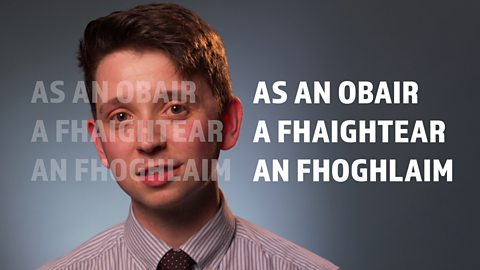As an Obair a Fhaightear an Fhoghlaim

As an Obair a Fhaightear an Fhoghlaim
Learning Comes Through Work
Nótaà d'FhoghlaimeoirÃ
If you have a ‘cúpla focal’;
(It is) from work that (we) get learning – i.e. ‘Learning is got from work’.
You will see that there are two clauses here, the main clause ‘As an obair’ (from work) and a realative clause ‘a fhaightear an fhoghlaim’ (that learning is got).
On first glance, the main clause has no verb but the copula is understood to be at the beginning of the clause but it is used optionally. Therefore one could say ‘Is as an obair... .
‘As’ is a preposition meaning ‘from’.
There are two nouns here both feminine, about which you will learn as you progress in your studies.
‘An’ (the) is the definite article which aspirates the initial consonant of the following feminine noun. Therefore ‘foghlaim’ (learning) becomes ‘an fhoghlaim’ .
‘Faightear’ is the present autonomous form of the verb ‘faigh’ (get). Autonomous means the verb does not have an obvious subject or the subject is not mentioned. It is aspirated after the relative particle ‘a’. ‘faightear > a fhaightear, which silences the ‘f’ in speech.
If you’re an advanced learner;
Notice that there are two clauses in this sentence. The main clause ‘As an obair’ (It is from work) and the relative clause ‘a fhaightear an fhoghlaim’ (that learning is got).
The main clause does not have an obvious verb but the copula is understood and can be optionally used which means we could write ‘Is as an obair... .
The relative clause begins with the relative particle ‘a’ which aspirates the initial consonant of the following verb – ‘faightear’ > ‘a fhaightear.
‘Faightear’ is the present autonomous form of the verb ‘faigh’ (get). Autonomous means that the subject of the verb is not mentioned.
The two nouns ‘obair’ (work) and ‘foghlaim’ (learning) are preceded by the definite article ‘an’ which is used before an abstract noun when that noun is referred to in a general way.
Look at the difference between these sentences:
‘Tá obair le déanamh agam’ – ‘I have work to do’, i.e. a specific job.
‘Tá an obair maith duit’ – ‘Work is good for you’ i.e. work in a general sense.
The two nouns are feminine which means that the preceding article aspirates the consonant at the beginning of the following noun. Therfore ‘foghlaim’ becomes ‘an fhoghlaim’.
If you’re fluent but would like to improve your grammar;
Tabhair faoi deara go bhfuil dhá chlásal san abairt seo, mar atá, príomhchlásal ‘As an obair’ agus clásal coibhneasta ‘a fhaightear an fhoghlaim’.
D’fhéadfaí an abairt a scríobh mar seo:
‘Faightear an fhoghlaim as an obair’ ach bogtar ‘as an obair’ chun tosaigh ar mhaithe le béim a chur air.
Tá dhá ainmfhocal againn anseo ‘obair’ agus ‘foghlaim’ atá baininscneach. Feicfidh tú go bhfuil consan caol ag deireadh an dá ainmfhocal, ‘obair’, ‘foghlaim’, comhartha go minic go bhfuil focal baininscneach againn. Ó tharla go bhfuil na focail baininscneach cuirtear séimhiú ar thúschonsan ‘foghlaim’ > ‘an fhoghlaim’.
Is minic a chuirtear an t-alt, ‘an’, roimh ainmfhocal teibí nuair a phléitear an focal ar dhóigh ghinearálta. Amharc ar an difear idir an dá abairt seo.
‘Tá obair le déanamh agam’ – obair ar leith.
‘Tá an obair maith duit’ – obair go ginearálta.